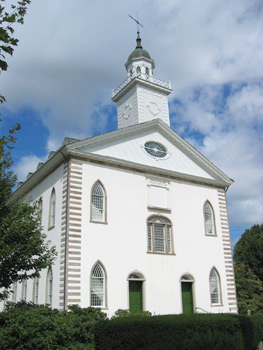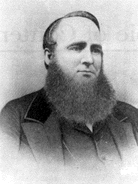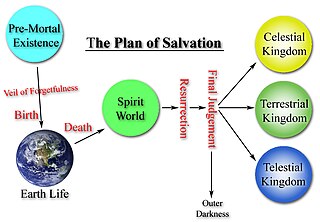
Kirtland is a city in Lake County, Ohio, United States. The population was 6,937 at the 2020 census. Kirtland is known for being the early headquarters of the Latter Day Saint movement from 1831 to 1837 and the site of the movement's first temple, the Kirtland Temple, completed in 1836. The Kirtland Temple and nearby Historic Kirtland Village are maintained as historic sites highlighting that era. The city is also the location for multiple parks in the Lake Metroparks system, as well as the Holden Arboretum.

The Latter Day Saint movement is a religious movement within Christianity that arose during the Second Great Awakening in the early 19th century and that led to the set of doctrines, practices, and cultures called Mormonism, and to the existence of numerous Latter Day Saint churches. Its history is characterized by intense controversy and persecution in reaction to some of the movement's doctrines and practices and their relationship to mainstream Christianity. The purpose of this article is to give an overview of the different groups, beliefs, and denominations that began with the influence of Joseph Smith.
David Wyman Patten was an early leader in the Latter Day Saint movement and an original member of the Quorum of the Twelve Apostles. He was killed at the Battle of Crooked River and is regarded as a martyr by members of the Church of Jesus Christ of Latter-day Saints. He is referred to twice in the Church of Jesus Christ's Doctrine and Covenants—once in section 114 and posthumously in section 124.

Luke Johnson was a leader in the Latter Day Saint movement and an original member of the Quorum of the Twelve Apostles from 1835 to 1838. He served in the Quorum with his younger brother, Lyman E. Johnson, and Orson Hyde, his brother-in-law.

Far West was a settlement of the Latter Day Saint movement in Caldwell County, Missouri, United States, during the late 1830s. It is recognized as a historic site by the U.S. National Register of Historic Places, added to the register in 1970. It is owned and maintained by the Church of Jesus Christ of Latter-day Saints.

The Kirtland Temple is the first temple built by adherents of the Latter Day Saint movement. It is located in Kirtland, Ohio, United States, and was completed and dedicated in March 1836. Designed by Joseph Smith, the founder and original leader of the movement, the architecture mixes the Federal, Greek Revival, and Gothic Revival styles. The temple was added to the National Register of Historic Places in 1969 and named a National Historic Landmark in 1977. Prior to March 5, 2024, it was owned and operated by Community of Christ for more than a century. Since that date, it has been owned and operated by the Church of Jesus Christ of Latter-day Saints as a historic site open year-round for guided tours, meetings, and other programming.

William Earl McLellin was an early leader in the Latter Day Saint movement. One of the original members of the Quorum of the Twelve Apostles, McLellin later broke with church founder Joseph Smith.

Amasa Mason Lyman was an early leader in the Latter Day Saint movement and was an apostle. He was also a counselor in the First Presidency to Joseph Smith.

Hiram Township is one of the eighteen townships of Portage County, Ohio, United States. The 2020 census listed 2,396 people in the township.

Isaac Morley was an early member of the Latter Day Saint movement and a contemporary of both Joseph Smith and Brigham Young. He was one of the first converts to Smith's Church of Christ. Morley was present at many of the early events of the Latter Day Saint movement, and served as a church leader in Ohio, Missouri, and Utah Territory.

In the theology and cosmology of The Church of Jesus Christ of Latter-day Saints, in heaven there are three degrees of glory which are the ultimate, eternal dwelling places for nearly all who have lived on earth after they are resurrected from the spirit world.

Reynolds Cahoon was an early leader in Latter Day Saint movement and later, in The Church of Jesus Christ of Latter-day Saints. He was one of the inaugural members of the Council of Fifty, organized by Joseph Smith Jr in 1844.
Ezra Booth was an early member in the Latter Day Saint movement who became an outspoken critic of Joseph Smith and the Church of Christ. He was "the first apostate to write publicly against the new Church". Before joining the early Church of Christ in 1831, Booth worked as a Methodist Episcopal minister and a farmer in Ohio. After his baptism, he moved with his family to Kirtland and served as a missionary, preaching in Missouri and Ohio. Booth left the church later in 1831, five months after his baptism. He proceeded to write a series of nine letters denouncing Mormonism that were published by the Ohio Star.
In the theology of the Latter Day Saint movement, an endowment refers to a gift of "power from on high", typically associated with the ordinances performed in Latter Day Saint temples. The purpose and meaning of the endowment varied during the life of movement founder Joseph Smith. The term has referred to many such gifts of heavenly power, including the confirmation ritual, the institution of the High Priesthood in 1831, events and rituals occurring in the Kirtland Temple in the mid-1830s, and an elaborate ritual performed in the Nauvoo Temple in the 1840s.

Historic Kirtland Village is a historic district in Kirtland, Ohio, U.S., owned and operated by the Church of Jesus Christ of Latter-day Saints. The district is made up of buildings and sites important to the early Latter Day Saint movement. Some of the buildings are original and have been restored to their 1830s appearances, while others were rebuilt on or near their original sites. In addition to Historic Kirtland, the church also owns and operates the nearby Kirtland Temple, the Isaac Morley Farm just east of Kirtland in Kirtland Hills, and the John Johnson Farm in Hiram.

The Church of Jesus Christ of Latter-day Saints in Ohio refers to the Church of Jesus Christ of Latter-day Saints and its members in Ohio. The official church membership as a percentage of general population was 0.52% in 2014. According to the 2014 Pew Forum on Religion & Public Life survey, roughly 1% of Ohioans self-identify themselves most closely with The Church of Jesus Christ of Latter-day Saints. The LDS Church is the 14th largest denomination in Ohio.
John Johnson Sr. was an early leader in the Latter Day Saint movement in Ohio.

The following outline is provided as an overview of and topical guide to the life and influence of Joseph Smith:

The life of Joseph Smith, Jr. from 1831 to 1837, when he was 26–32 years old, covers the period of time from when Smith moved with his family to Kirtland, Ohio, in 1831, until he left Ohio for Missouri early in early January 1838. By 1831, Smith had already published the Book of Mormon, and established the Latter Day Saint movement. He had founded it as the Church of Christ, but eventually dictated a revelation to change its name to the Church of Jesus Christ of Latter Day Saints.
















